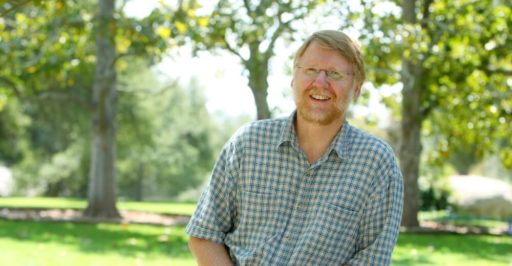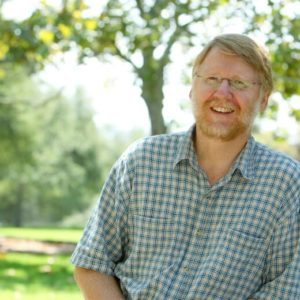We recently spoke with author Paul J. Willis about his new Slant book, All in a Garden Green
Where did you get the idea for the story?
Years ago, my wife and I took a group of college students for a fall semester of study at Hengrave Hall in England. Our children were with us, and I always wondered afterward what the visit was like for them. So, I did some research about the place and found that it had a distinctive musical history. I also learned some interesting things about the visit of Queen Elizabeth to Hengrave Hall in 1578. So, 1578 became the date to which the children in the story went back in time.
Are the children in the story directly based on your own, then?
Not really. Our own children were five and seven at the time; the main characters in the story, Erica and Pedro, are 13. I pretty much made them up out of thin air. The same is true of their mother. Their overwhelmed father, a college professor, bears some resemblance to me, though.
How do you know how people really talked in 1578?
I’ve read and studied quite a few books that were written in the sixteenth century, including lots of Shakespeare; the story, in fact, takes place when Shakespeare was fourteen years old. (When he was getting his start in the theater in his early twenties, he probably came with a traveling group of actors to perform at Hengrave Hall.) Though we don’t know exactly how people talked back then, their speech was not as far removed from ours as we might think. Shakespeare didn’t write in Old English but in what is called Early Modern English. In his time, the word you was already starting to replace the words thee and thou.
Where did you get the title for the story?
“All in a Garden Green” is the name of the song that Erica plays on the piano and the virginal. It was popular in the court of Henry VIII and was still popular in the court of his daughter Elizabeth.
Do you play the piano?
I had lessons in grade school but got tired of them and quit. I was much more interested in writing! My son is a really good drummer, though, and I have watched the way in which music has taken hold of him.
This is your first book for a younger crowd—say, precocious middle readers through young adult readers. What do you hope they will take away from All in a Garden Green?
Lately it has been the fashion to talk about “measurable learning outcomes.” I really can’t stand the idea of measurable learning outcomes! The pioneer Yosemite climber Yvon Chouinard has said that adventure is the uncertainty of outcome. I want anyone who reads this book to have an adventure. I can’t predict where that adventure will take them in their imagination.
That said, I do have to admit that insofar as the story dips into the deep sense of conflict between Catholics and Protestants in sixteenth-century England, I do want to educate young readers about what that might have been like—and to warn them away from taking part in that kind of conflict as they get older. In the end of the story, the power of music becomes an almost magical way in which this conflict (at least for the moment) is resolved. I suppose I want to provide some hope that our differences, however intractable, can be transcended.
Are there classic books in this genre that you read as a child that were memorable and influential?
The first book I ever read by myself, at the tender age of six, was The Lion, the Witch, and the Wardrobe, by C. S. Lewis. It took me two weeks to get through it, but the story cast a spell over me. When I finished reading, I had the clear and distinct thought that I couldn’t imagine anything better to do in life than to write a book like this. Outside my office door at Westmont College is a wardrobe from C. S. Lewis’s house that exactly matches the description of the one in the book. Every day it serves to remind me of that first reading experience and that first desire to write. If All in a Garden Green casts a similar spell over some other young person, that would make me supremely happy. Think of it as an immeasurablelearning outcome!
All in a Garden Green also owes something to Mark Twain’s The Prince and the Pauper, also a story of swapped identities in sixteenth-century England. I found this an absolutely delightful book when I was young. I also recall The Man Who Was Magic, by Paul Gallico, as creating a window of new feeling inside of me. And a whole series of books by Edgar Eager, one of which is called Knight’s Castle, gave me a comforting sense of young friends transported into unexpected places.
Have you written other novels?
I have published four eco-fantasy novels in one big book, The Alpine Tales. My brother calls them “Narnia comes to the American wilderness.” They are set in a mythic version of the Cascade Range in the Pacific Northwest, and are full of climbing, hiking, skiing, caving, and river-running adventures, not to mention a few talking marmots.
Is there anything that makes this particular novel special to you—different from the rest?
Unlike The Alpine Tales, this story is not about forests and mountains. Most of my writing is nature writing of one sort or another, but All in a Garden Green takes place in an old English manor house. I guess we all need a break sometimes from our accustomed material.
This book is also different from the others in how at least part of it got written: the climactic chapters came all in a rush in a single night. I had spent the day in a very sad way, helping a friend who had just been divorced move some of his stuff out of his house. That evening I felt emotionally exhausted. After dinner I sat down to revise a few pages of what I had written thus far, but then, unexpectedly, I kept going. And going. It was as if the story were being told to me, and my job was to just keep up. When I got to the end of the significant action, and Erica had come back to her own time, I looked up and found that the sun was coming through the window and my wife and kids were having breakfast. Some writers experience this sort of thing all the time, but I am usually more of a plodder.
Do you have any plans for a sequel to All in a Garden Green?
I have drafted a sequel in which Erica’s little brother, Walter, goes back in time to visit a pioneer community in the wilds of California. Of course, he gets himself in trouble, so Erica has to go back in time herself again to help him out. The story takes place in a wilderness area behind my home in Santa Barbara, so this puts me back on familiar ground.


